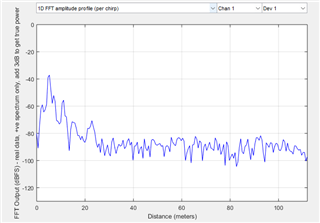Other Parts Discussed in Thread: AWR2944, , IWR6843
Tool/software:
Hi,
we are trying to close the theoretical and the laboratory link budget estimation.
I configured the EVM for the following scenario:



My setup looks like this:

AWR2944 is located 5m far from a corner reflector with a side length of 0.1m (RCS 27.6m^2)
And I got this measurements:

I checked that without a corner reflector, static environment reflections at 5m range are below -55dBFS, so the signal power of -40dBFS reflects the reflector signal power accurately.
Based on the theoretical calculation, I got the same Signal power for this configuration, but the noise floor is expected to be 20dB below, that is, in place of -103dBFS, somewhere -123dBFS.
No other noise sources exist in the lab.
I read here IWR6843AOPEVM: SNR calculation - Sensors forum - Sensors - TI E2E support forums about ~13dB Phase Noise floor level that should be added to close the link budget. But is was for IWR6843. I'm wandering whether it may be the reason for 20dB discrepancy that we observe. What is the phase noise level that should be taken into consideration for AWR2944EVM? And whether it comes from the Cristal and then may be improved by its replacement or it is the chip itself that limits FN?
Thank you,
Arie



